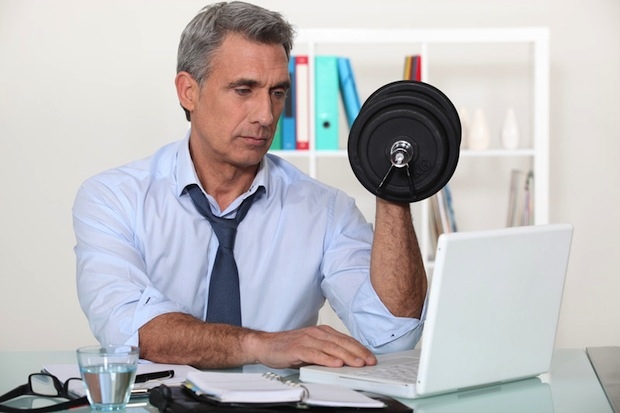The human body is designed to move, yet the average American sits at a desk job for approximately 10 hours a day. Prolonged sitting and staring at a computer all day can bring about all kinds of health problems such as: migraines, circulation diseases, weight gain, poor posture and eye strain. It’s no wonder such a large percentage of Americans are over-weight and unhealthy.
In continuation on the topic of my last article: Need a Raise? Exercise! (where I talked about how a recent study concluded that those who exercise get paid more) here are some tips to actually get some exercise while at the office, and maybe even help you get that raise!
“Exercise at the office? Well, I don’t want everyone to stare at me!” is probably the first thought that crossed most of your minds. Keep in mind that most of your co-workers are probably suffering from the same “desk issues” as you are. If you start exercising at your desk you’re probably more likely to start a trend then to have everyone pointing and laughing.
Still nervous?
There are plenty of “subtle” things you can do. Remember that any movement is better than no movement. Just simply taking the stairs, standing every half hour or so, or taking a stroll to the water cooler will at least help get the blood moving, and prevent muscle stiffness.
Other Minimal adjustments you should do include:
1. Get a good chair that is designed for deskwork in order to prevent posture problems associated with hunching over your computer keyboard. Set your chair backrest at an angle larger than 90°. Your back should be straight, your shoulders back, and the top of your computer monitor should be at eye level. Take it a step further and invest in a large size stability ball or stability ball-style desk chair. A stability ball will cause you to have to keep balance, so you will naturally sit straighter and work your core muscles. An actual stability ball is more effective, but the chair is a more feasible option to use at the office. When using the actual ball be sure to start off with no more than 15 minutes at a time in order to get your body used to it. You can even try a standing desk! For more info click here
2. To help prevent Carpal Tunnel Syndrome make sure your wrists don’t rest on the keyboard or mouse pad (unless you have a pad with a wrist rest).
3. Give your eyes a break from the computer and look out the window or at other objects in the room every 30 minutes or so. It is best to look at something at a distance to maintain ocular health. This will lessens chances of eyestrain and headaches.
4. Ab squeezes are a great way to get a mini ab workout. Tighten your ab muscles, hold for a few seconds and release. Repeat 15 times.
5. Drink plenty of water. Have a bottle of water by your side and make a habit of drinking at least 8 glasses throughout your day. For all the great benefits you get from water read: A Secret Fix for Better Health.
Simple Stretching
Stretching is also a subtle way to keep your body moving. It will prevent muscles from clenching up and shortening, and is also a great stress release. Take advantage of certain work situations; stretch while on a call or waiting for a file to load.
Here are a few suggestions:
Neck: Bend your head to the right as if trying to put your right ear on your right shoulder. Grab your head with your right hand and gently pull your head down toward your shoulder until you feel a slight stretch on the left side of your neck. Hold for a few seconds. Release and repeat on the left side.
Shoulders: Roll your shoulders forward around 10 times, then backward.
Chest and Shoulders: Sitting up straight, lace your fingers behind you, palms facing each other. Slowly raise your hands, while simultaneously sticking out your chest. Hold, release and repeat.
Wrists: Extend your right arm in front of you, wrist bent with your fingers facing down and palm facing you. Place your left hand on the back of your right hand and gently push your palm towards you. Hold for 15-30 seconds and repeat with the other arm. Next, perform the same stretch, but with the palm facing away from you and fingers pointing up. Finish with a wrist rotation to help increase blood flow; first clockwise then counterclockwise.
Ankles: As with your wrists, rotate the ankles in a clockwise motion 3 times, then counterclockwise.
Legs: While sitting, lift your legs straight out in front of you, one at a time. Tense your quad muscle and flex your foot. Hold and then point your foot. Repeat with the other leg.
Lower Back: Place your hands, finger pointed downward on your lower back. Lean back and push your chest out and up, keeping your elbows pointing straight back. Hold for 15 seconds then relax. Repeat a couple of times.
Spine: Begin by sitting normally in your chair, and then move your legs toward the right side so that you are sitting on a diagonal. Turn your upper body towards the left and grab the back of your chair on the left side with your right hand. Don’t forget to breath. Hold for a few seconds and repeat on the left side. Resistance bands are great tools to help increase your stretches. Compact and light they are easy to store in desk drawers.
Feeling Adventurous?
If you don’t care what others think (good for you!), have a private office, or access to an empty conference room, here are some exercise ideas that will actually give you a great mini workout.
60-Second Cardio
Getting your heart pumping (even if it’s just for 60 seconds at a time) has been shown to increase longevity and decrease heart disease risk. Here are a few quickie cardio exercises to try between work tasks:
- Do as many jumping jacks as you can in one minute.
- March in place for 60 seconds
- Pretend jumping rope for a minute: Hop on alternate feet, or on both feet at once.
- Do walk-lunges in your office or an empty conference room.
Strength-Building Exercises:
Chair Dips: To work your triceps and shoulders, place both hands on your chair arms, fingers facing forward, and slowly lift your bum off the chair. Lower yourself back down but stop short of fully sitting, hold for a few seconds. Repeat 15 times.
Desk pushups: (only do if your desk is strong enough to support your weight.) Stand facing your desk and put your hands on it’s edge . Walk your feet backwards until your body is at a comfortable angle. Lower your chest towards your desk as far as you can, then slowly return to starting position. Do three sets of 8-12 reps.
Ab Crunch: Sit on the edge of your chair, lean back from the waist keeping your back straight. Hold the seat of your chair with both hands. With knees bent, lift both legs, while tightening your abs. Straighten your legs holding your heels up a few inches off of the floor. Do 10 reps.
Chair Squats: For a great leg and butt workout, begin by standing in front of your chair with your back towards it. Bend your knees and lower yourself. Tap your bum on the chair, then return to standing position. Keep your arms straight out in front of you to keep balance. Do 3 sets of 8-12 reps.
Glute Extensions: Holding your desk for support, keep legs straight, extend one leg behind you and lift it as high as you can (without arching your back). Do 3 sets of 8-12 reps. Repeat on the other side.
Make it a Team Sport!
Invite co-workers to join you on a lunchtime walk. Take it a step further and join a near by gym with your fav co-worker and go during your lunch hour. Having a workout buddy to hold you to it will keep you motivated. Many offices are now creating workout programs in office. Lobby your boss for a lunchtime yoga or tai chi class, or to allow the use of BreakPal.com. BreakPal.com is a great site that will send you mini workout ideas at time intervals of your choosing. There is a “Company Trial” link on their site!
Remember that while exercising at your desk is helpful, you should still exercise for at least 30 minutes, 3 days a week. Don’t be shy! Go ahead and try a few of these deskercise suggestions. Taking short exercise breaks throughout your work day can energize you, reduce frequent pain, and actually make you more efficient at your job.
Sources: wikihow.com, livestrong.com, webMD, workawesome.com





 Payments powered by:
Payments powered by:

